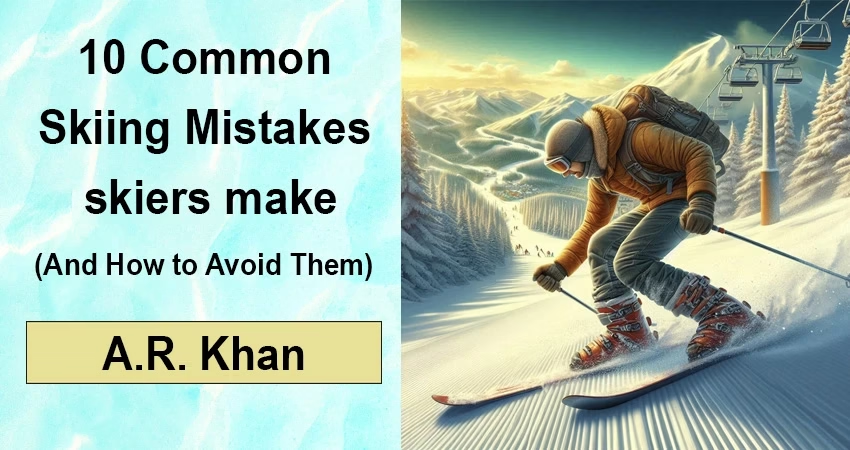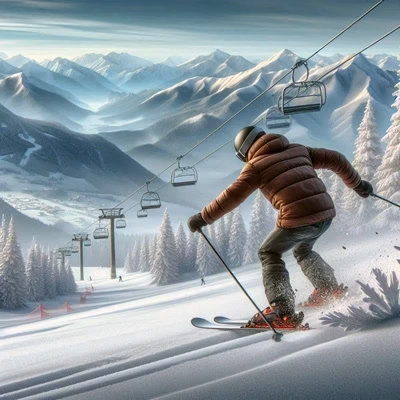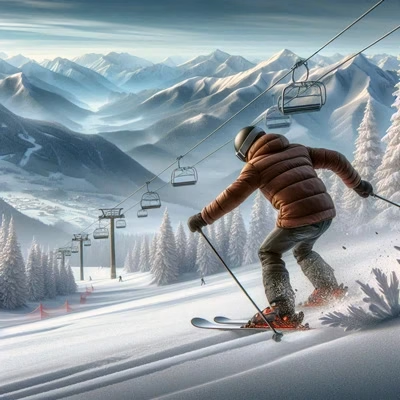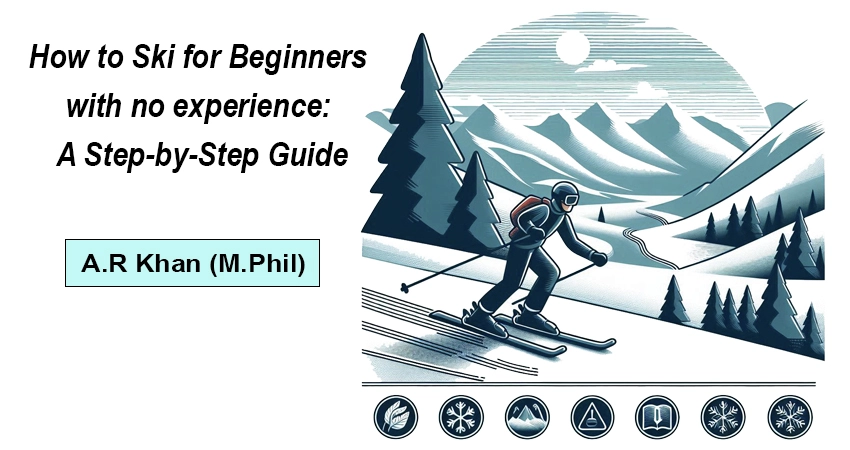Introduction
Skiing is an exhilarating sport, but for beginners, the learning curve can feel steep. From mastering balance to navigating icy slopes, new skiers often face challenges that lead to frustration, injuries, or stalled progress. In this guide, we’ll break down the 10 most common skiing mistakes new skiers make—like improper gear choices, poor posture, and overconfidence—and provide actionable solutions to help you ski smarter, safer, and with more confidence. Whether you’re planning your first skiing trip or looking to refine your technique, these skiing tips for beginners will set you up for success.
1. Choosing the Wrong Gear: A Costly Skiing Mistake for Beginners
Many first-time skiers either rent or purchase improperly fitted equipment due to budget constraints, lack of knowledge, or convenience. Wearing ill-fitting boots, selecting skis that are too long or stiff, or neglecting essential safety gear can significantly impact performance and comfort on the slopes. Additionally, improperly adjusted bindings can reduce control and increase the risk of injuries.
How to Avoid Common Skiing Mistakes
Prioritize Flexibility and Fit: Beginners should opt for softer, shorter skis that provide better maneuverability and control, making it easier to learn and progress.
Invest in Proper Footwear: Ski boots should fit snugly but not be excessively tight. A good fit ensures comfort and proper weight distribution, which enhances balance and stability.
Never Compromise on Safety Gear: Helmets and goggles are essential for protecting against head injuries and reducing glare from the snow. Choose high-quality gear designed for skiing to ensure maximum protection and visibility.
Adjust Bindings Professionally: Having bindings set up correctly according to your skill level and weight can significantly enhance safety and prevent unnecessary falls.
💡 Pro Tip: Prepare for varying weather conditions by layering with moisture-wicking fabrics. Proper ski attire keeps you warm and dry, ensuring a comfortable and enjoyable experience on the slopes.
2. Skipping a Warm-Up
The thrill of skiing often makes beginners eager to jump straight onto the slopes without preparing their bodies. However, skipping a proper skiing warm-up exercise can lead to muscle stiffness, poor coordination, and an increased risk of strains, sprains, or fatigue. Skiing is a physically demanding sport that engages multiple muscle groups, including the legs, core, and stabilizing muscles. Without proper preparation, skiers may experience reduced mobility, slower reaction times, and a higher likelihood of injuries.
How to Avoid This Common Skiing Mistakes
Incorporate Dynamic Stretches: Before stepping onto the snow, dedicate at least 5–10 minutes to warming up key muscle groups. Perform exercises such as:
- Leg Swings – Improve hip mobility by swinging each leg forward and backward.
- Lunges with Twists – Stretch and activate the legs, hips, and core.
- Torso Rotations – Enhance flexibility in the midsection for smoother turns and better balance.
Practice Balance and Coordination Drills: Skiing requires excellent stability and muscle control. Strengthening your balance before hitting the slopes can significantly improve your performance and prevent falls. Try:
- Single-Leg Stands – Stand on one foot for 30 seconds, then switch to the other leg.
- Balance Board Exercises – Mimic skiing movements by practicing small shifts in weight on a balance board.
Engage in Light Cardio: Warming up with gentle movements, such as jogging in place or jumping jacks, increases blood flow and prepares your muscles for movement. This helps prevent sudden strain when you start skiing.
💡 Pro Tip: Consider skiing lessons for beginners—most professional instructors include warm-up routines in their sessions to ensure students start off safely and develop good habits from the beginning.
By taking a few extra minutes to warm up, new skiers can significantly enhance their performance, reduce the risk of injuries, and enjoy a more comfortable and controlled skiing experience.
3. Leaning Back (The “Backseat” Mistake): A Common Beginner Error
One of the most frequent skiing mistakes beginners make is leaning too far back, often referred to as the “backseat” position. This typically happens due to a natural fear of gaining too much speed or losing control. Instead of staying centered, new skiers shift their weight onto their heels, moving away from the middle of their skis. This incorrect posture makes turning more difficult, reduces responsiveness, and places excessive strain on the legs—leading to faster fatigue and a higher risk of falls.
How to Avoid This Common Skiing Mistake
Stay Centered for Better Control: Proper skiing posture requires keeping your weight balanced over the center of your skis. To achieve this:
- Gently press your shins against the front of your ski boots.
- Keep your hips aligned over your ankles rather than leaning too far back or bending excessively at the waist.
Bend Your Knees, Not Your Waist: A slight forward lean is key to maintaining control. Rather than bending at the waist, focus on:
- Keeping your knees slightly flexed to absorb terrain changes.
- Engaging your skis’ edges properly for smooth turns and controlled stops.
Use Your Core and Lower Body for Stability: Instead of relying solely on your legs, engage your core muscles to stabilize your movements. Strong core engagement helps distribute weight evenly and prevents unnecessary backward shifts.
💡 Pro Tip: Master turning techniques with ease! When initiating a turn, lean forward slightly rather than leaning back. This keeps your weight over the skis’ contact points, improving maneuverability and reducing the likelihood of catching an edge.
By staying centered, maintaining a proper stance, and embracing a slight forward lean, new skiers can gain confidence, improve their balance, and enjoy a smoother, more controlled experience on the slopes.
4. Ignoring Weather and Slope Conditions: A Risky Oversight for Beginners
Many novice skiers focus solely on their skills and excitement, often overlooking how weather and slope conditions can significantly impact their experience. Unpredictable factors such as ice, fog, heavy snowfall, or steep terrain can make skiing much more challenging than expected. Ice can cause skis to slip uncontrollably, fog can limit visibility, and steep or uneven slopes can lead to falls and injuries. Without proper awareness, beginners may find themselves in conditions that exceed their skill level, increasing the risk of accidents.
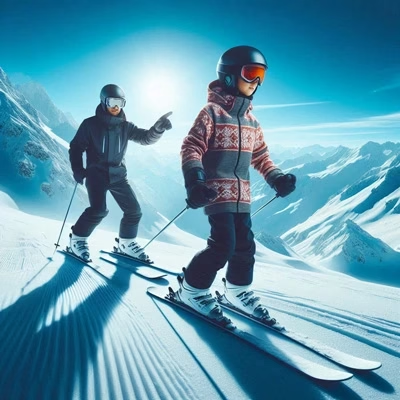
How to Avoid This Common Skiing Mistake
Check the Weather and Slope Reports Before Skiing:
- Monitor the forecast for snow conditions, temperature changes, and visibility levels.
- Avoid skiing during icy mornings or whiteout conditions until you gain more experience.
- Understand how different conditions affect the terrain—fresh powder is easier to navigate, while icy slopes require more control and technique.
Choose the Right Slopes for Your Skill Level:
- Start on green circle trails, which are designed for beginners with gentle, well-groomed terrain.
- Avoid black diamond or off-piste runs until you have mastered basic techniques and feel confident on intermediate slopes.
- If unsure, ask ski resort staff for recommendations on the best trails for your ability level.
💡 Pro Tip: Understanding skiing slope etiquette is just as important as mastering technique! Always yield to skiers ahead of you, avoid making sudden stops in the middle of the trail, and never block high-traffic areas—especially in places with limited visibility.
By staying informed about weather conditions, choosing appropriate slopes, and respecting ski etiquette, beginners can enjoy a safer, more enjoyable skiing experience while building their confidence on the mountain.
5. Overestimating Skill Level: The Danger of Advancing Too Soon
Why This Happens: After a few successful runs on beginner slopes, many new skiers develop a false sense of confidence and rush to tackle more advanced terrain. While enthusiasm is great, skipping essential skill development can lead to frustration, poor technique, and even serious injuries. Unlike beginner slopes, intermediate and advanced trails require more refined control, quicker reaction times, and the ability to navigate steeper, icier, or more unpredictable conditions. Overestimating one’s ability can slow progress, reinforce bad habits, and diminish overall enjoyment.
How to Avoid This Common Skiing Mistake
Progress Gradually and Build a Strong Foundation:
- Focus on mastering the basics—controlled stopping, smooth turns, and linking turns seamlessly—before moving beyond green circle trails.
- Once comfortable on beginner slopes, slowly transition to blue square runs, which introduce more speed and variability without being overwhelming.
- Avoid the temptation to follow more experienced skiers onto difficult trails before you’re ready.
Take Professional Lessons for Faster, Safer Improvement:
- Certified ski instructors help you build confidence and technique in a structured, step-by-step manner.
- Lessons provide valuable feedback on posture, balance, and weight distribution, helping you avoid bad habits.
- Group or private coaching sessions can significantly improve your skills while reducing the risk of injury.
💡 Pro Tip: Want to refine your technique before advancing? Incorporate foundational drills like “pizza turns” (snowplow technique) to practice controlled stopping and turning. These basic maneuvers lay the groundwork for parallel skiing, improving overall control and confidence on steeper slopes.
By pacing yourself, focusing on proper technique, and seeking guidance from experts, you’ll develop stronger skiing skills, progress more efficiently, and enjoy a safer and more rewarding experience on the slopes.
6. Poor Pole Usage: Mastering the Art of Proper Pole Control
For many beginners, ski poles feel like an extra set of limbs—awkward and difficult to control. Some grip them too tightly, mistakenly relying on them for balance, while others swing them excessively, disrupting their rhythm and coordination. Misusing ski poles can throw off a skier’s posture, make turning more difficult, and even increase the risk of injuries, such as wrist strains or shoulder discomfort. Understanding their correct function is key to improving stability, control, and overall confidence on the slopes.
How to Avoid This Common Skiing Mistake
Use Poles for Timing, Not Balance:
- The primary purpose of ski poles is to assist with rhythm and timing, especially when initiating turns—not to serve as crutches for stability.
- Lightly plant your pole just before turning to create a smooth, controlled motion.
- Avoid jabbing the pole too forcefully into the snow, as this can throw off your balance.
Maintain a Relaxed, Natural Grip:
- Hold your poles with a firm but relaxed grip—think of it like holding a bicycle handle rather than squeezing for dear life.
- Keep your elbows at a 90-degree angle with your arms slightly in front of your body, helping you maintain a centered stance.
- Avoid swinging the poles too high or too far behind you; keep movements controlled and subtle.
💡 Pro Tip: Incorrect pole usage can lead to wrist and arm strain! Many beginners suffer from skiing common injuries like wrist sprains due to improper pole planting or an overly tight grip. To prevent this, make sure to wear properly fitted wrist guards or gloves with built-in support, and focus on smooth, fluid movements rather than excessive force.
By learning to use ski poles effectively, beginners can enhance their turning technique, maintain better posture, and ski with greater confidence and efficiency.
7. Neglecting Hydration and Nutrition: The Hidden Risk of Skiing Fatigue
Why This Happens: Many beginners underestimate the physical demands of skiing, often forgetting to hydrate or fuel their bodies properly. Cold weather naturally reduces the sensation of thirst, making it easy to go hours without drinking water. Meanwhile, skiing is a high-energy sport that burns between 300 and 600 calories per hour, depending on intensity and terrain. Without adequate hydration and nutrition, skiers may experience fatigue, muscle cramps, dizziness, or decreased coordination, all of which increase the risk of accidents.
How to Avoid This Common Skiing Mistake
Stay Hydrated Throughout the Day:
- Bring an insulated water bottle and take small sips frequently, even if you don’t feel thirsty.
- Consider hydration packs or water reservoirs designed for skiers, which allow for easy access while on the move.
- Avoid excessive caffeine, which can contribute to dehydration.
Pack Energy-Boosting Snacks for Sustained Performance:
- Keep light, high-energy snacks like energy bars, trail mix, or nuts in your ski jacket for quick refueling.
- Opt for complex carbohydrates and proteins to maintain stamina and prevent sudden energy crashes.
- Eat a balanced meal before hitting the slopes to ensure you have enough fuel for an active day.
Avoid Alcohol While Skiing:
- While an après-ski drink is a common tradition, alcohol consumption impairs balance, slows reaction time, and dehydrates the body—all of which can increase the risk of injury.
- Save alcoholic beverages for after you’ve finished skiing for the day.
💡 Pro Tip: Proper hydration and nutrition enhance performance! Pairing a well-fueled body with skiing warm-up exercises helps activate muscles, improve endurance, and reduce the risk of fatigue-related falls.
By staying hydrated, maintaining steady energy levels, and making smart dietary choices, skiers can improve endurance, stay focused, and enjoy a safer, more enjoyable experience on the slopes.
8. Staring at Your Skis: A Common Beginner Skiing Mistake
New skiers often feel nervous about their technique and instinctively stare down at their skis to monitor their movements. While this might seem like a good way to maintain control, it actually disrupts balance, reduces spatial awareness, and makes it harder to navigate the slopes effectively. Looking down shifts your weight improperly, making turns more difficult and increasing the risk of falls.

How to Avoid This Common Skiing Mistake
Keep Your Eyes Focused Ahead:
- Instead of looking down at your feet, focus 10–15 feet ahead on the path you’re taking.
- This allows you to anticipate turns, obstacles, and changes in terrain before you reach them.
- A forward gaze helps distribute weight properly, keeping you balanced and in control.
Trust Your Peripheral Vision:
- Your body naturally follows where your eyes lead—so if you keep looking at your skis, you’re more likely to lean forward or lose stability.
- By using your peripheral vision, you can stay aware of your ski position while still keeping your head up and scanning your surroundings.
- This technique improves reaction time, helping you adapt to the slope’s conditions without hesitation.
💡 Pro Tip: Want to reduce your chances of falling? One of the best skiing tips for avoiding falls is maintaining good posture and awareness—keep your head up, shoulders relaxed, and focus on where you want to go. This enhances coordination, balance, and overall confidence on the slopes.
By training yourself to look ahead instead of down, you’ll ski more smoothly, react faster to changes in terrain, and develop better overall control—making your skiing experience safer and more enjoyable.
9. Wearing Cotton Clothing: A Recipe for Cold and Discomfor
Many beginners unknowingly wear cotton clothing when skiing, assuming it will keep them warm. However, cotton is highly absorbent and retains moisture from sweat, snow, or melting ice, leaving skiers feeling damp and chilled. Unlike moisture-wicking fabrics, cotton does not dry quickly, making it a poor choice for cold-weather sports. Wearing the wrong clothing can lead to discomfort, reduced mobility, and even hypothermia in extreme conditions.
How to Avoid This Common Skiing Mistake
Choose Proper Ski Layering for Warmth and Comfort:
- Wear moisture-wicking base layers made of synthetic fabrics like polyester or merino wool to keep sweat off your skin.
- Use insulating mid-layers (such as fleece or down jackets) to trap body heat.
- Always wear a waterproof and windproof outer layer to shield against snow, wind, and wet conditions.
Avoid Cotton and Denim at All Costs:
- Cotton socks, shirts, or sweatpants soak up moisture and dry slowly, making them unsuitable for skiing.
- Denim is heavy, non-waterproof, and restricts movement, making it an uncomfortable and impractical choice for ski pants.
- Instead, opt for waterproof ski pants and insulated ski jackets designed specifically for winter sports.
By dressing appropriately in moisture-wicking, insulating, and waterproof layers, you’ll stay warm, dry, and comfortable throughout your skiing adventure, ensuring a more enjoyable and safer experience on the slopes.
10. Avoiding Lessons: The Fastest Way to Develop Bad Habits
Many beginners believe they can teach themselves to ski or rely on friends for guidance to save money. While skiing may seem straightforward, improper technique can lead to bad habits that make progress slower and increase the risk of injuries. Without professional guidance, new skiers may struggle with balance, posture, turning, and stopping—all of which are essential for safe and enjoyable skiing.
How to Avoid This Common Skiing Mistake
Invest in Professional Ski Lessons:
- Whether you choose a group or private lesson, a certified instructor provides structured training tailored to your skill level.
- Lessons help you develop proper stance, turning techniques, and stopping methods, which are crucial for controlling speed and avoiding falls.
- Instructors also teach essential safety tips, such as how to get up after a fall and how to navigate different slope conditions.
Supplement Learning with Online Resources:
- Watching tutorials from professional ski instructors on platforms like YouTube can reinforce what you learn in lessons.
- Focus on videos that break down techniques like carving, parallel turns, and weight distribution for better control.
- While online videos are helpful, they should not replace in-person training, as real-time feedback is essential for correcting skiing mistakes.
💡 Pro Tip: Want to accelerate your learning curve? Following skiing tips for first-time skiers—like taking lessons early—will help you avoid frustration, build confidence, and minimize the risk of injury.
By prioritizing professional instruction and supplementing with educational resources, beginners can develop good skiing habits from day one, making their time on the slopes safer and more enjoyable.
Conclusion: Set Yourself Up for Success on the Slopes
Skiing is an exhilarating and rewarding sport, but for beginners, small skiing mistakes can lead to discomfort, frustration, or even injuries. By avoiding these common skiing mistakes, you can enhance your experience and build confidence on the slopes. From selecting the right ski gear to maintaining proper posture and technique, small adjustments can significantly impact your performance.
Remember, even the most skilled skiers started as beginners. Progress takes time, so be patient, embrace the learning process, and prioritize professional lessons to develop strong fundamentals. As you gain experience, these skiing tips will help you avoid unnecessary falls and injuries, allowing you to enjoy every moment on the mountain.

